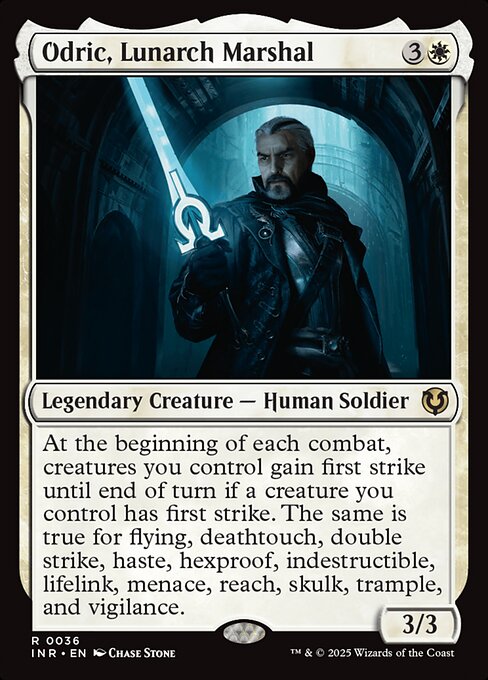
Image courtesy of Scryfall.com
Luck vs Skill in MTG Strategy: Odric's Combat Conundrum
Magic: The Gathering has long teased a delicate balance between randomness and mastery. No matter how deep your plan, a misdraw or a sudden swing on the battlefield can tilt a match in a heartbeat. Odric, Lunarch Marshal embodies that tension in a very white-knight way. This legendary Human Soldier from Innistrad Remastered arrives with a modest 3/3 body for {3}{W}, but its true power lies in the edge it lends to skilled players who know how to choreograph a sequence of combat turns. The card’s oracle text—"At the beginning of each combat, creatures you control gain first strike until end of turn if a creature you control has first strike. The same is true for flying, deathtouch, double strike, haste, hexproof, indestructible, lifelink, menace, reach, skulk, trample, and vigilance"—turns a simple white board into a tactical aquarium where every move ripples outward. 🧙♂️🔥
Odric’s ability is both elegant and punishing: it rewards you for building a deck that actually has the right keywords in play, but it also punishes players who rely on a single bomb or a random top-deck to win. In practice, Odric is a strong reminder that in combat-focused formats, skillful sequencing and keyword synergy often beat raw speed or sheer card advantage. The effect is not a blanket buff; it’s a conditional blanket that wraps your entire team in the exact protection or aggression you’ve engineered for that moment. The result is a dance of probability and planning, where the luck of your draws intersects with the precision of your attack steps. ⚔️🎨
From a design perspective, Odric’s value increases with the diversity of your creature suite. The list of keywords that can be granted—ranging from first strike and flying to vigilance and trample—lets you tailor a strategy that fits your local meta. If you’re piloting a go-wide white deck, Odric acts as a force multiplier: a single creature with first strike on turn three can cascade into a battlefield-wide first strike for the rest of the turn, provided you already control a creature with that ability. The same logic applies to trample, reach, lifelink, and more. White’s identity as a combat-focused color finds a compelling ambassador in Odric, who makes disciplined execution feel almost cinematic. 🧙♂️⚡
Designing around Odric: practical paths to victory
- Keyword diversity: Build around a spectrum of creatures that already carry these keywords or can reliably gain them through Odric’s trigger. A board rich with first strike, flying, or vigilance gives you more meaningful swings each combat step.
- Combat sequencing: Plan your turns so that you maximize value right as combat begins. If you can push a first-strike line or give your team flying just as your opponent’s blockers appear, you’ll often lock in bites you wouldn’t otherwise secure.
- Protective redundancy: Because Odric’s effect depends on having at least one creature with a given keyword, you want to avoid a dead turn if your only keyworded creature is removed. Card draw and recursion can help keep the keyword train running.
- Tempo considerations: Odric rewards tempo shifts. A well-timed Odric turn can convert a midgame standoff into a decisive assault, but overextending can invite removal that strips the board of your keywords just when you need them most.
- Commander playstyle: In EDH/Commander, Odric shines when your command zone supports long, grindy attrition with a diverse creature suite. Its rarity as a rare reprint in Innistrad Remastered underscores its enduring appeal as a strategic centerpiece rather than a one-off spike card. EDHREC rank around 1399 signals a healthy, veteran audience that appreciates the craftsmanship of its combat-centric design. 🧩
Beyond the mechanics, Odric’s flavor aligns with the aspirational aura of white—discipline, unity, and justice on a battlefield that can swing on a single, well-timed announcement to your army. The art by Chase Stone (Innistrad Remastered) depicts a marshal rallying a disciplined cohort, a visual cue that the real power lies in how you marshal your forces rather than in any single ace on the board. The card’s dual identity as a white legend and a generous, if conditional, combat enabler makes it a staple for players who relish the tug-of-war between chance and strategy. The rare/foil presence in INR also invites collectors to revisit a modern classic that still feels fresh in a world of ever-expanding keyword soup. 💎
For players who love to study the interplay of luck and skill, Odric is a gateway card that invites you to ask: How would my game look if every creature I control carried the same combat keyword for one turn? The answer is often a vivid slice of MTG’s eternal magic—where probability dreams meet practiced execution and a well-timed buff becomes the difference between a stumble and a triumph. 🧙♂️🎲
As you plan your next white-centric build, keep Odric close. Whether you’re chasing a thrilling, high-tempo board state or a patient grind with a heavy emphasis on protection and value, the marshal’s call is an invitation to turn luck into a skillful, choreographed spectacle. And when you’re ready to take a little piece of that MTG magic into the real world, a rugged piece of gear can keep your deck, dice, and notes safe on the go—courtesy of the product below. 🧭
Rugged Phone Case Tough Impact Resistant TPU PC Shield
More from our network
- https://transparent-paper.shop/blog/post/ancient-star-detected-through-low-metallicity-clues-at-eight-thousand-light-years/
- https://blog.digital-vault.xyz/blog/post/mtg-card-design-lessons-from-make-your-own-luck/
- https://blog.digital-vault.xyz/blog/post/castle-locthwain-and-related-cards-a-continuity-chronicle/
- https://crypto-acolytes.xyz/blog/post/mastering-minecraft-pvp-essential-tips-for-victory/
- https://blog.digital-vault.xyz/blog/post/how-social-dynamics-shape-flaying-tendrils-popularity-in-mtg/